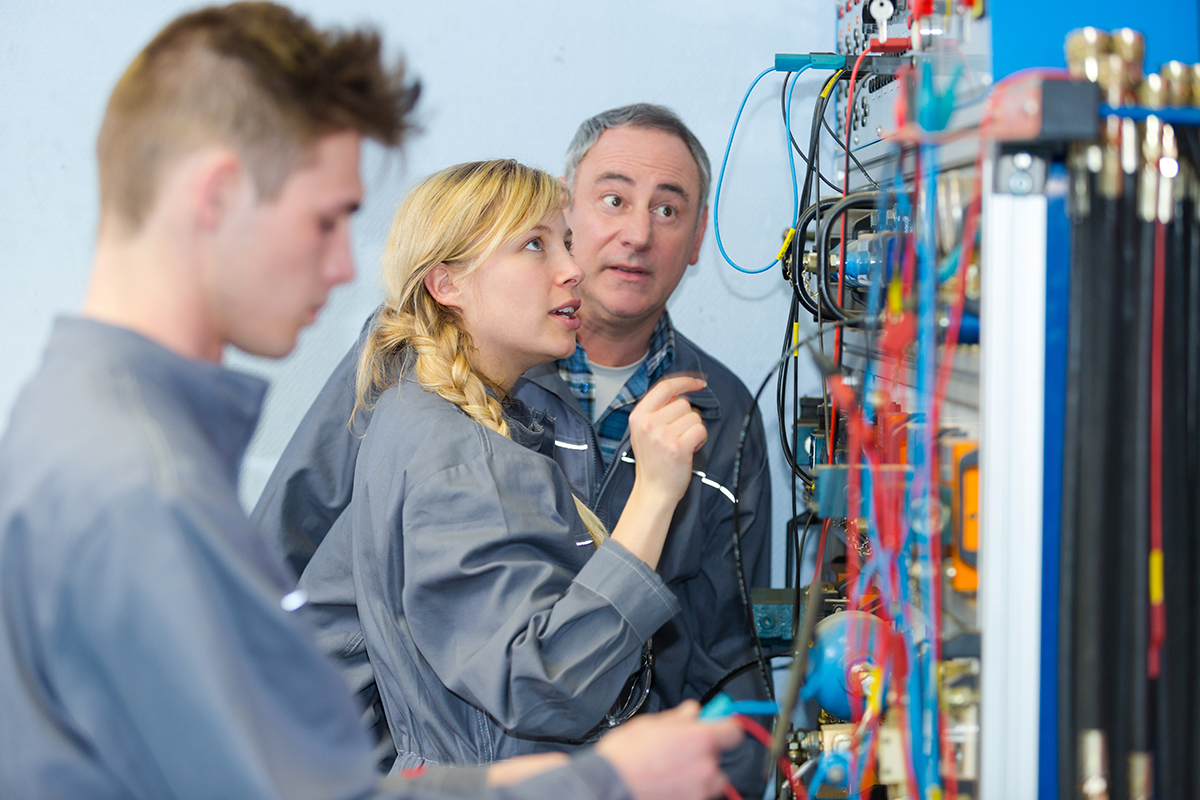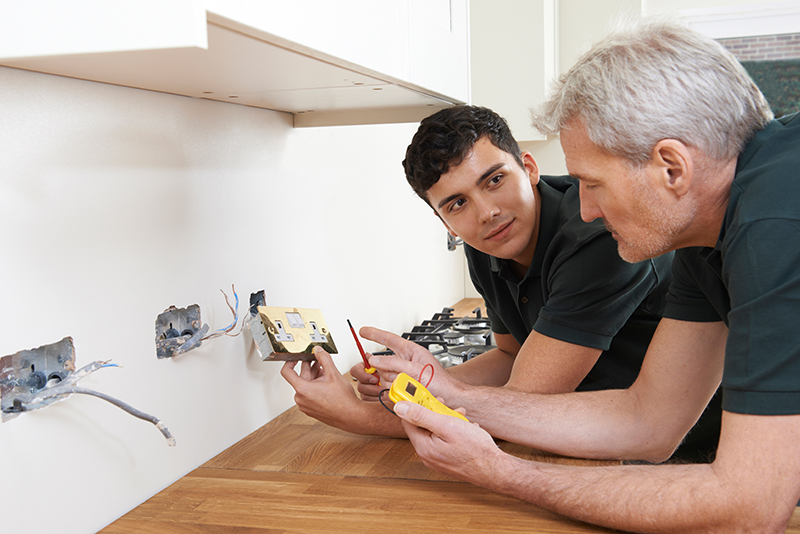Glossary of Electrical Terms (A – I)

Published: Friday, 08 March 2024
In the UK, we have over 26,000 electrical apprentices currently in training. Being able to know what each electrical term means can help you in your progression as an electrical apprentice to electrician. In this article we will be looking at the electrical terms from A – I.
This article is not intended to offer electrical installation advice. For any electrical problems or concerns, it is always advisable to seek independent professional assistance from a certified and qualified electrician.
A
Alternating Current (AC)
A.C. is the passage of an electric current through a conductor or circuit, first in one direction and then in the opposite direction.
Ammeter
An instrument used to measure electric current.
Ampere
A unit of electric current: Symbol A; unit symbol: I
Anode
The anode is a positive electrode or terminal, such as the + terminal of a battery.
Apparent Power
This is the power of an A.C. circuit calculated using the formula P = V x A x pf. If the alternating current circuit supplies a totally resistive load. For example, a heating element, the apparent and true power will be the same. This is known as 'Unity'.
ARC
A very low resistance between two sites with different potentials can cause an electrical discharge in the form of a spark or flash between them.
Armature
The phrase refers to the rotating component of a direct current electric motor or generator, as well as an alternating current universal motor.
Asynchronous
The term is used to describe the rotor speed of a.c. motors in which the rotating magnetic field created by stator windings is at synchronous speed, i.e. dependent on the supply frequency and number of sets of stator windings; as opposed to the actual rotor speed, which is less than synchronous and is referred to as asynchronous speed.
Atom
A nucleus, protons, and electrons are the minute components of a substance; a molecule is made up of many atoms.
Autotransformers
The primary connection is a static device made up of a laminated steel core and one winding that is coupled to a single-phase alternating current source. The secondary output is created by tapping off the same winding at a location that results in either a rise or decrease in output voltage. Three-phase autotransformers are also available.
B
Back E.M.F
Back E.M.F is a voltage generated in opposition to the supply voltage when an alternating current flows through a wire coil, such as a motor winding, choke, or relay coil.
Ballast
This is an alternative term for the choke found in discharge lighting circuits.
Bimetallic Strip
This is a component present in certain types of thermostats, such as room thermostats that control central heating systems. The strip is made up of two dissimilar metals linked together. When the temperature rises, one metal expands quicker than the other, causing the strip to bend. This can be used with a switch designed to turn on or off the central heating boiler.
Black
The insulation or marker colour associated with line 2 (L2) of a three-phase alternating current supply system.
Bonding
The technique of purposely connecting all exposed metal things not designed to transport electricity in a space or building to avoid electric shock if they accidentally become live.
Brown
The insulation or marker colour associated with Line 1 (L1) of a three-phase alternating current supply system.
C
Capacitor
A capacitor is a component that stores electric charge. It is made up of two or more conductive plates, sometimes known as metallic foils, that are insulated from one another and the container that houses them. The outside plates feature terminals, allowing the gadget to be linked to a circuit. This device can be found in alternating current single-phase motor circuits, discharging lighting installations, power factor correction units, and electronic circuits.
Carbon Brush
Carbon is a good electrical conductor and lubricant. As a result, the carbon brush is an effective way to transfer electrical energy into or out of the spinning component of an electric motor or generator.
Cathode
This is the negative electrode or terminal of a direct current power source, such as a battery.
Cell
A device that generates electricity by combining an electrolyte and conductive plates.
Charge
The electric charge is a quantity of electricity measured in Coulombs. Symbol Q.
Choke
This is a coil of wire twisted around a laminated steel core. The coil's low resistance and high inductance make it especially useful in a.c. circuits for (a) providing a high voltage when starting certain types of discharge lamps and (b) controlling the flow of current in low resistance circuits such as the discharge current through a fluorescent lamp when fully turned on.
Circuit Breaker
The circuit breaker is intended to protect circuits against overcurrent, which can be caused by a short circuit or overload in the circuit. The circuit-breaker includes both magnetic and bimetallic components that address each form of overcurrent fault in the circuit.
Combined Neutral Earth Conductor (CNE)
A conductor that serves as both neutral and earth in electrical circuits.
Commutator
This is a device found in direct current motors and generators, as well as some alternating current machines. It is made up of copper segments that are insulated from one another as well as the armature shaft around which they are fixed. Carbon brushes make contact with the copper segments, forming a ‘sliding electrical contact' that allows electrical energy to be supplied or removed from the armature.
Conductor
A substance with a low resistance to the flow of electric current, often copper but also aluminium.
Conventional Current
Conventional current refers to the anticipated flow of electric current in a circuit, which is current flowing from the supply source's positive to negative terminals through a load. Electron current flow represents the real current flow in a circuit.
Current
The flow of electric charge across a conductor, measured in amperes (A). Current Symbol: I

D
Direct Current (DC)
The flow of electric current in a circuit in a single direction rather than alternating.
Delta
A way of connecting electrical circuits in three-phase supply systems where the load is balanced, and no neutral connection is required.
DIAC
A solid-state device intended for use in conjunction with other solid-state devices to generate a pulsed waveform.
Dielectric
A dielectric is a material or region with a high resistance and thus a poor conductor of electricity. A capacitor's dielectric layer acts as an insulator between the conducting plates. Plastic, glass, porcelain, and certain metal oxides, as well as dry air, are poor conductors.
Diode
A solid-state device that enables current to flow in one direction but prevents it when the current is reversed, resulting in direct current.
Discharge
The term 'discharge' is typically linked with the passage of an electric current through a gas. However, the word can also refer to the lowering of a capacitor's stored electric charge to zero by connecting a resistor across its terminals.
Diverted Neutral Current (DNC)
Refers to unwanted current in the neutral conductor that takes unexpected courses in an electrical system.
Domestic dwelling
A house or flat is an example of a residential property.
E
Earthing
To ensure safety and functionality, key sections of an electrical power system are connected to the ground.
Eddy Current
A circulating current induced by an alternating current; in a transformer, eddy current occurs in the steel core that supports the windings. To minimise eddy currents, the steel core is laminated.
Electricity
The broad phrase used to describe the action of an electric charge, whether static or moving.
Electrical Power
Watts (W) are the units used to measure the rate of work. Power (P) is measured in watts and is the product of potential difference (volts) and current (amperes), hence in formula: - P = V x I, or P = U x I (H3) Electrode
This phrase can be used in several ways:
i) A conductor enables electric current to enter or exit a medium, such as electrolyte. As an example, consider a lead-acid battery.
ii) A semiconductor device, like diodes and transistors, uses an element to collect or emit electrons.
Generally, the phrase refers to the positive or negative terminal of a power source, such as a battery. The positive electrode is also known as the anode, and the negative electrode as the cathode.
Electromagnetic induction
When current travels through a conductor or coil, an electromagnetic field forms around it. The magnetic field is proportional to the current, therefore as the current increases or drops in value, so does the magnetic field's strength. When the magnetic field rises or falls, a voltage is induced in the wire or coil, which is referred to as the back-EMF.
Electro-Motive-Force (EMF)
Is the source of electrical energy used to generate current in a circuit. An alternator, battery, generator, solar panel, or thermocouple can all be the source of electromagnetic field.
Equipotential
To have the same electrical potential at all points.
Exposed-Conductive-Part
A conductive component of equipment that can be touched and is not ordinarily live, but can become so if the insulation fails.
Extraneous-Conductive-Part.
A conductive component that may introduce potential, often Earth potential, but does not form part of the electrical insulation.
F
Fault
An electrical problem may occur in the distribution network, electrical installation, or electrical equipment. A defect can be a short circuit, an open circuit, or a component failure.
Fault Current
This is the current generated by a defect in the electric circuit. The fault could be an electrical short-circuit or a mechanical overload.
Fleming's Left and Right Hand Rules
Sir John Fleming devised two regulations. The rules are intended to help people comprehend the link between motion, electromotive force, and magnetic flux in electric machines. Hand rules use each hand's first and second fingers, as well as its thumb, to depict magnetic flux, electric current, and the ensuing movement.
The Left Hand Rule applies to electric motors, and the Right Hand Rule to electric generators.
Flux
i) A material used to aid fusion during soldering
ii) A phrase that describes the rate of flow or movement of a property, such as magnetic, luminous, or electric flux.
Frequency
This is the number of cycles per second that an alternating current voltage is provided from the distributor; frequency is expressed in Hertz (Hz).
Fuse
An overcurrent protection device that opens the circuit when an abnormally large current flows through an electrical circuit or apparatus. An abnormally high current could be the result of an electrical failure or overload.

G
Generator
A mechanical energy converter; equipment capable of converting non-electrical energy into electrical energy.
Grey
The insulation or marker colour associated with Line - 3 (L3) of a three-phase alternating current supply system.
Ground
The earth's total mass in terms of earthing systems.
H
Heater Electric
A device made of high-resistance wire that transforms electrical energy into heat energy.
Hygroscopic
A moisture-absorbing substance; a phrase commonly linked with the insulating material ‘magnesium oxide' used in mineral-insulated cables. When exposed to air, magnesium oxide absorbs moisture, reducing its insulation properties.
I
IET
The Engineering and Technology Institution; provides electrical installation needs.
Illumination
The light level on a surface provided by natural or artificial methods; boosting the light level is typically accomplished with the use of electric lamps.
Impedance
The entire opposition to current flow in an alternating current circuit in which resistance, inductance, and capacitance can all contribute to opposing current flow. Inductance is measured in ohms. Symbol: Z.
Inductance
Inductance is the opposition to current flowing through a coil when a changing current produces a changing magnetic field to induce an opposing voltage; it is measured in Henry's (H). The gadget is used to control the current flowing through a circuit.
Inductor
A static device consisting of a coil installed on a laminated steel core and used to provide inductance in a circuit. A choke in a fluorescent luminaire circuit is an example.
Insulator
One example of a substance in which electric current cannot flow is p.v.c.
Isolator
The isolator is a mechanical device that isolates all live conductors from a circuit or specific piece of equipment by breaking the circuit with a mechanical switch device.
Learning these terms will help you gain an understanding of information needed as an electrician. In our next article we will be covering electrical terms from J – R.
We also offer a variety of Articles, Guides, and News you could find useful in different areas of your work in the future.

